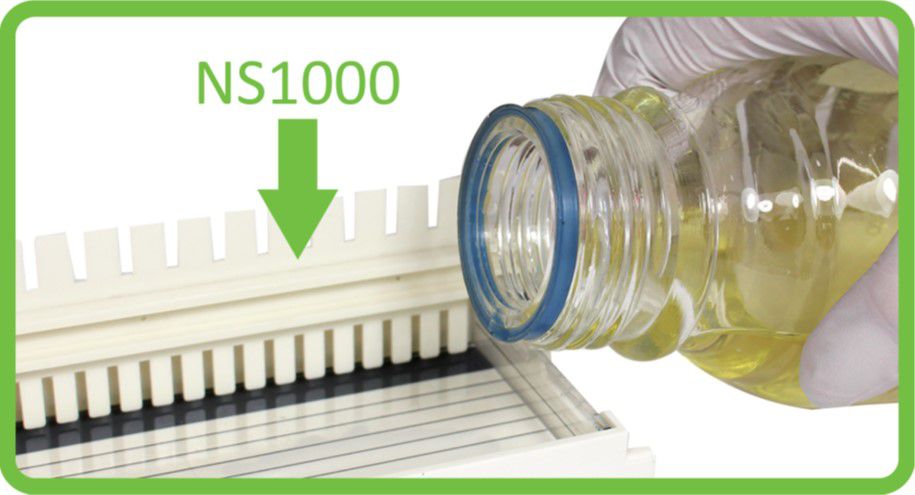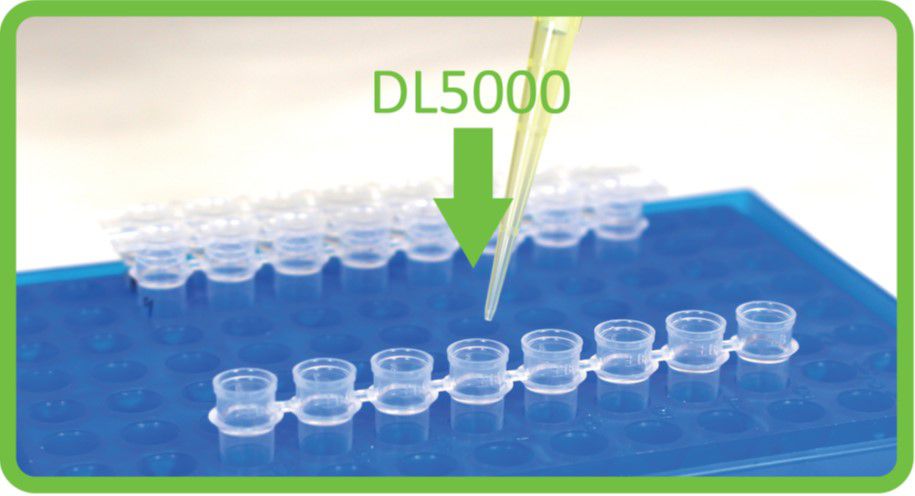[DM2400] AccuBand™ 100 bp+3K DNA Ladder II, 500 μl
Description
AccuBand™ 100 bp+3K DNA Ladder II is composed of 14 individual DNA fragments, presenting 3k, 2k, 1.5k, 1.2k, 1k, 900, 800, 700 600, 500, 400, 300, 200 and 100 bp sharp bands respectively. This product contains 2 enhanced bands (1k and 500 bp) for easy band identification. AccuBand™ 100 bp+3K DNA Ladder II is ready-to-use, containing loading buffer with dual color tracking dyes (orange G and Xylene cyanol FF). AccuBand™ 100 bp+3K DNA Ladder II provides a sufficient amount of DNA for clear observation of all DNA bands ranging from 100 bp to 3 kb, either in agarose gel or in polyacrylamide gel electrophoresis.
Features
Sharp bands
Suitable for polyacrylamide gel electrophoresis
Quick reference— enhanced bands
Ready-to-use— premixed with loading dye for direct loading
Stable— room temperature storage over 6 months
Source
Phenol extracted PCR products and dsDNA digested with specific restriction enzymes, equilibrated in 10 mM Tris-HCl (pH 8.0) and 10 mM EDTA.
Range
100 ~ 3,000 bp
Concentration
54.4 µg/ 500 µl
Recommended loading volume
5 µl/ well
Storage
Room temperature for 6 months
4°C for 12 months
-20°C for 36 months
Specification
Cat. No. | DM2400 |
Series Name | AccuBand™ |
Product Size | 500 μl |
Size Range | 100 – 3000 bp |
Band Number | 14 |
Tracking Dye | Orange G and Xylene cyanol FF |
Enhanced Band | 500 and 1000 bp |
Are the DNA markers/ladders produced by SMOBIO sufficient in quantity?
Yes, all the DNA markers of SMOBIO have been passed in the QC processes including repeated optical density measurements to ensure the quantity of total DNA.
Are the SMOBIO's DNA markers/ladders compatible to radio-labeling (for example, label DNA with T4 Polynucleotide Kinase)?
We do not recommend to do the labeling reaction directly.
The reasons are as follows:
Our DNA marker is pre-mixed with loading buffer that contains Tris-HCl, EDTA, and glycerol, may affect radio-labeling.
Our DNA marker is a mixture of PCR products and restriction enzyme digested DNA fragments. Digested dsDNA may still have phospho-group on their 5' end.
To enhance the efficiency of the labeling reaction, here are two steps suggested being done prior to the labeling reaction:
Purify DNA marker by EtOH precipitation or DNA purification kits to remove loading buffer.
Remove phospho-group by using phosphatase, ex CIAP (Calf intestinal alkaline phosphatase)
Are SMOBIO's DNA markers/ladders suitable to use in DNA PAGE?
SMOBIO's AccuBand™ series DNA markers (DM1200, DM2000, DM2200 and DM2400) are suitable for DNA PAGE.
Why DNA markers/ladders are resolved two bands at the same size when using high percentage agarose or polyacrylamide gel?
DNA fragments with identical in size are indistinguishable on agarose gels, but, on acrylamide gels, even slight differences in DNA sequence can lead to noticeably different migration rates. To provide increased intensity of DNA marker/ladder bands, multiple DNA fragments with identical in size but different in DNA sequences are used. SMOBIO's AccuBand™ series DNA markers (DM1200, DM2000, DM2200 and DM2400) are more suitable for DNA PAGE.
Are SMOBIO's DNA markers/ladders suitable to use in denaturing DNA PAGE?
SMOBIO's AccuBand™ series DNA markers (DM1200, DM2000, DM2200 and DM2400) are suitable for DNA PAGE.
SMOBIO's AccuBand™ DNA markers are not at denatured form, therefore, you need to denature DNA ladder by yourself.
Here is the protocol to denature DNA ladder:
Mix 5 μL of DNA Ladder with an equal volume of denaturing solution [95% (v/v) formamide, 10 mM EDTA (pH 8.0), 0.1% (w/v) bromophenol blue, 0.1% (w/v) xylene cyanol].
Incubate at 70°C for 5 minutes.
Electrophorese the sample in a denaturing polyacrylamide/urea gel
Chlorogenic Acid Inhibits Progressive Pulmonary Fibrosis in a Diabetic Rat Model
Sagita Mega Sekar Kencana, Nur Arfian, Ratih Yuniartha, Ramadhea Laila Afifa An-Nur Willya Saputri, Fauziyatul Munawaroh, Dwi Cahyani Ratna Sari
Iran J Med Sci. 2024 Feb; 49(2): 110–120. Published online 2024 Feb 1. doi: 10.30476/IJMS.2023.96535.2868
PMCID: PMC10862105
Ploypassorn Homklinkaew, Sakuna Phatthanakunanan, Siriluk Jala, Alongkot Boonsoongnern, Preeda Lertwatcharasarakul
Vet World. 2023 Nov; 16(11): 2313–2320. Published online 2023 Nov 19. doi: 10.14202/vetworld.2023.2313-2320
PMCID: PMC10750741

FluoroVue™ Nucleic Acid Gel Stain
Excellent for in-gel staining
Sensitivity up to 0.14 ng DNA or 1 ng total RNA
A safer alternative to EtBr
Suitable to blue or UV light

FluoroStain™ DNA Fluorescent Staining Dye
Excellent for post staining
Sensitivity up to 0.04 ng DNA
A safe alternative to EtBr
Suitable for blue or UV light

FluoroDye™ DNA Fluorescent Loading Dye
Excellent for premix with DNA sample
Sensitivity up to 0.14 ng DNA
Safety dye
Convenience - monitor the electrophoresis in real-time

![[DM2400] AccuBand™ 100 bp+3K DNA Ladder II, 500 μl](/web/image/product.template/209/image?unique=3829480)

![[DM2400] AccuBand™ 100 bp+3K DNA Ladder II, 500 μl](/website/image/product.template/209/image/90x90)



